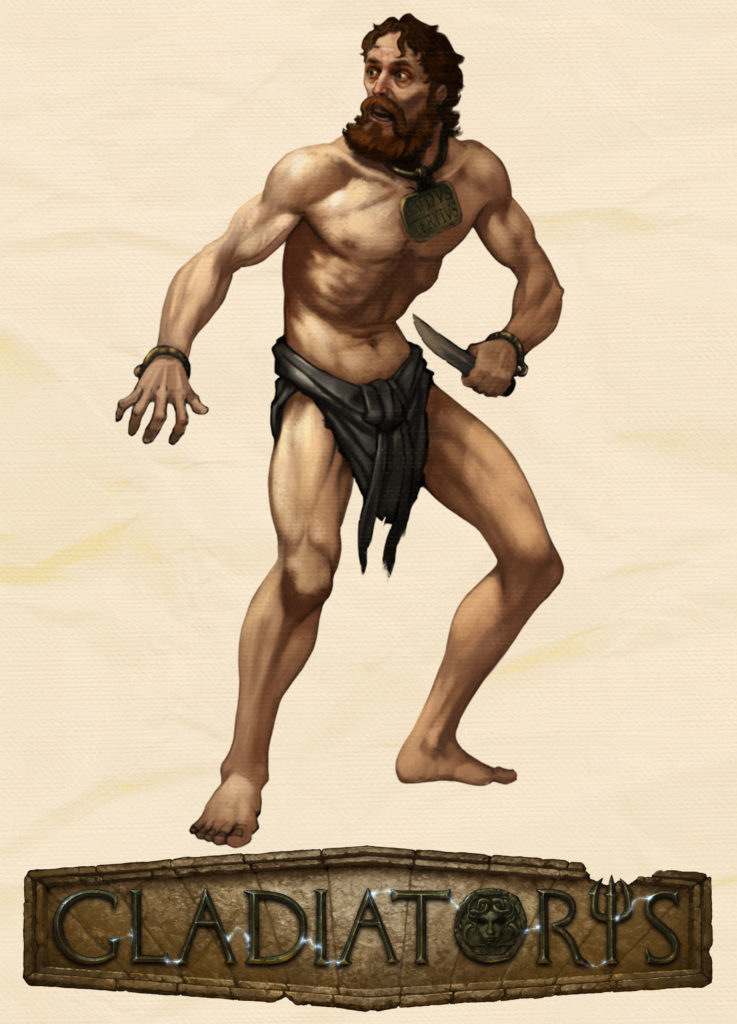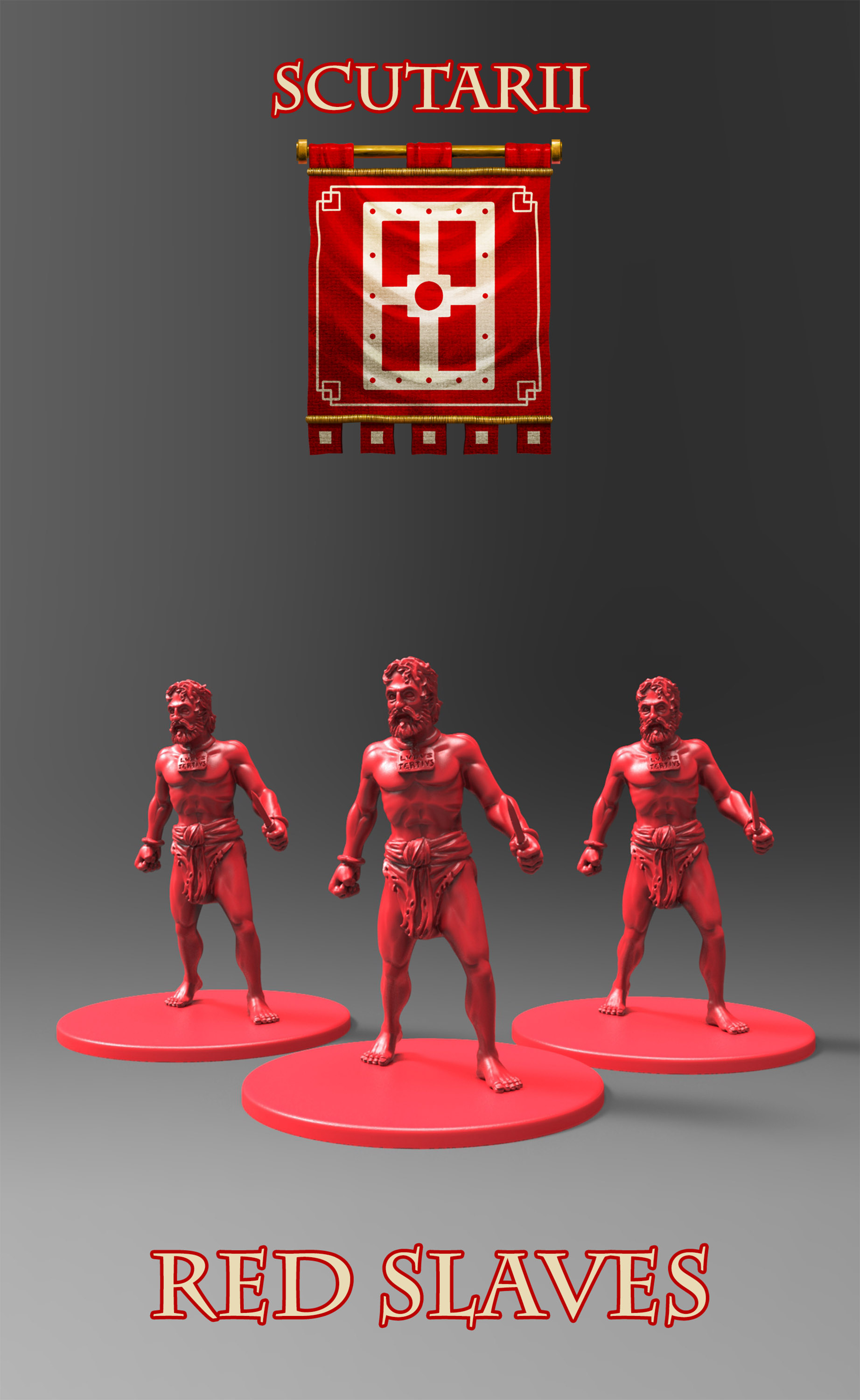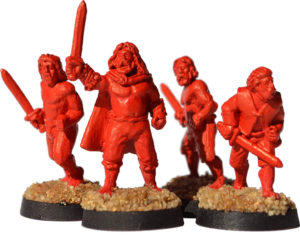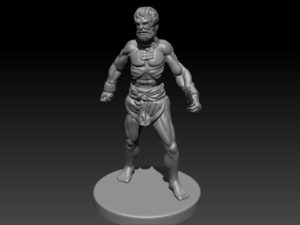 slaves
slaves
They are common criminals, sentenced to death by the sword at the games (damnati ad gladium). Their survival is not expected, as they have no chance when facing expert gladiators or lethal beasts.

At level II, like all Slaves from the basic set, they lose the Flee skill (that forbids them to counterattack a fumbling enemy). These poor fellows, at least, receive a knife to defend themselves, with the weapon ability Sharp.
Design process

With the Gaul-like Slaves from the prototype as a starting point, we began designing a new generic Slave that would serve for all teams with just a change of color (but with the possibility of customizing them in the future, as a crowdfunding stretch goal).
We chose an anxious, waiting stance, and 3DBreed (with whom we had just ended the bas-reliefs and the atlas for the national TV series Carlos, Rey Emperador sent us a first sketch, with whipping marks on the back.
[slideshow_deploy id=’585′]
I trusted my doubts to Alfonso about the hypermusculated Slave.
Alfonso: “He looks fine to me. Just because he’s a slave he doesn’t have to look famished. Think about a prisoner of war: being a soldier, he had to be strong. Also, not a lot of time has passed since his capture (there was no time for him to lose much weight due to a poor diet) because in the Roman world, there weren’t any prisons (with the goal of depriving someone of freedom; they thought it was a nonsense to spend money to feed their prisoners). The period of time between the capture and the exhibition in the Arena (if they were damnatus or noxius) was not very long. Also, keeping the prisoners hungry was bad regarded and could cause problems for the jailer, because his duty was to keep them healthy and strong to offer a good show. It’s documented in Passio Sanctarum Perpetuae et Felicitatis.”
Of course, we accepted Alfonso’s judgement; not only he is an expert on munera history, but a Athleticism teacher too.
We also talked about the shackles: “(…) if anything, they should be a little thinner (in Classic roman world, metal was very expensive and wasn’t wasted. Chains, shackles and the like were “thin”… i.e. One could not break them, so there was no need of extra thickness). But maybe they need to be thick to look good on the miniature. In any case, when slaves and convicts went into the Arena, they would do it without chains, shackles and other constraints, so they could fight without hindrance and offer a good show.”
But they must be recognized as Slaves and we decided against them being unshackled when going into the Arena. I had doubts about the thickness, and the type of shackle; I thought they should be rings, with circular section…
Alfonso: “By the way, most sources show shackles on the neck, and it seems they preferred it that way instead of restraining their wrists (I have not found any visual source showing shackles on the wrists). It’s logical: in the neck you only need a single ring, and you can subdue the prisoner with a yank (and that’s not the case with wrists). A suggestion, in case you like it: in Rome, slaves wore a plate on their necks with their owner’s data so that they could be returned to them in case of scape. Perhaps you’d like to add a plate to the slave (this is not applicable if he’s a prisoner of war or a convict).”
I find this idea wonderful, and it can be seen on movies from time to time. We copied the historical reference sent by Alfonso, the slave collar from the Museo Nazionale Romano: a ring with an engraved plate, announcing the reward for returning the slave to his owner.

Alfonso: “What’s written on the inscription? It should be Latin, and a correct Latin. Not many inscriptions from slave collars have survived until today, but one of them -found in Rome- says the following: “Tene me ne / fugia(m) et revo/ca me ad dom(i)nu(m) m/eu(m) Viventium in / ar(e)a Callisti” (CIL, XV, 7193: “Hold me so I don’t flee, and take me back to my master, Viventius, [who lives] at Callisti district”). That’s way too long to have it on the miniature, but I think we could write “revoca me ad dominum meum”, or simply “ad dominum meum”.”
David: “I asked them if they could write just “LUDUS TERTIUS” in two lines. It’s not to tease Luis at all as I did when working in the Exodus movie (Ridley Scott, 2014), when baptized the Egyptian streets with the names of my RPGs and Blood Bowl characters, hehe (Go Randcrist!). Luis and I have a healthy rivalry, shown in the second GLADIATORIS cover: his beloved Lusitor versus my dear Thraex.”
[slideshow_deploy id=’591′]
And this is the final Slave, after the last revision (or maybe transformation)!
